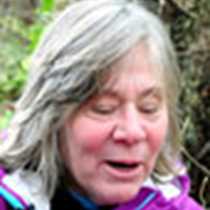Ideal Cove & Petersburg
Large and uneven age trees, a complex understory, downed trees and nurse logs in various stages of decomposition; these are some of the markers of old growth forest. Moss-covered and lichen-draped, the deep forest of Sitka spruce and western hemlock towering high over the boardwalk invites us to experience a certain quietness of mind, a rightness of spirit not easily found away from the natural world.
Small delights lay everywhere; chicken of the woods, a delectable orange fungus just sprouting out of several downed logs, as well as ripe blueberries and salmon berries to pluck for our mid-morning snack. Most walkers made it up the trail to enjoy a view of a beaver dam and a long lake strewn with yellow pond lilies and forest reflections.
Following an inspiring presentation on humpback whales by Dr. Fred Sharpe of the Alaska Whale Foundation, we docked in Petersburg, a rural Alaskan town dedicated to fishing. Bike riding, flightseeing, shopping, and bog walking were among the afternoon’s choices.
Bog, muskeg, peatland; about fifteen percent of the Tongass National Forest is covered by soggy sphagnum mosses surrounding small ponds that reflect the lichen coated and stunted trees of this special habitat. Cool wet summers and areas of poor drainage promote the formation of muskeg, and the buildup of partially decomposed plant materials creates a rather acidic condition inhospitable to the usual forest plants. This allows different species of trees and unusual miniature plants a place to succeed.
Coastal pines, Alaska yellow cedar, and mountain hemlock can compete here, and plants like the round leaved sundew have evolved to capture tiny insects for nutrients.




